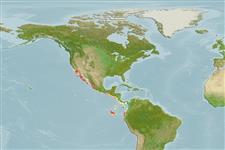Environment: milieu / climate zone / depth range / distribution range
Ecología
marino bentopelágico; rango de profundidad 0 - 865 m (Ref. 5123). Subtropical; 35°N - 7°S
Eastern Pacific: southern region of California Current south of 35°N.
Tamaño / Peso / Age
Maturity: Lm ? range ? - ? cm
Max length : 26.6 cm SL (female)
Short description
Claves de identificación | Morfología | Morfometría
Espinas dorsales (total) : 0; Radios blandos dorsales (total) : 9 - 10; Espinas anales: 0; Radios blandos anales: 8 - 9; Vértebra: 43 - 46. Branchiostegal rays 4. Predorsal length greater than 49% SL. Caudal peduncle length greater than 13% SL; depth less than 8% SL in specimens more than 3 cm (Ref. 5123).
Adults are found in continental slope regions. Oviparous, with planktonic eggs and larvae (Ref. 35612). Larvae and juveniles pelagic in the upper 200-m layer and more broadly distributed than adults (Ref. 5123).
Life cycle and mating behavior
Maturities | Reproducción | Spawnings | Egg(s) | Fecundities | Larva
Moser, H.G. and J.L. Butler, 1996. Microstomatidae: argentines and pencilfishes. p. 208-215. In H.G. Moser (ed.) The early stages of fishes in the California Current Region. California Cooperative Oceanic Fisheries Investigations (CalCOFI) Atlas No. 33. 1505 p. (Ref. 35612)
IUCN Red List Status (Ref. 130435)
Threat to humans
Harmless
Human uses
Herramientas
Special reports
Download XML
Fuentes de Internet
Estimates based on models
Preferred temperature (Ref.
123201): 7.8 - 14.8, mean 11.4 °C (based on 35 cells).
Phylogenetic diversity index (Ref.
82804): PD
50 = 0.5000 [Uniqueness, from 0.5 = low to 2.0 = high].
Bayesian length-weight: a=0.00389 (0.00180 - 0.00842), b=3.12 (2.94 - 3.30), in cm total length, based on all LWR estimates for this body shape (Ref.
93245).
Nivel trófico (Ref.
69278): 3.4 ±0.4 se; based on size and trophs of closest relatives
Fishing Vulnerability (Ref.
59153): Low vulnerability (22 of 100).
